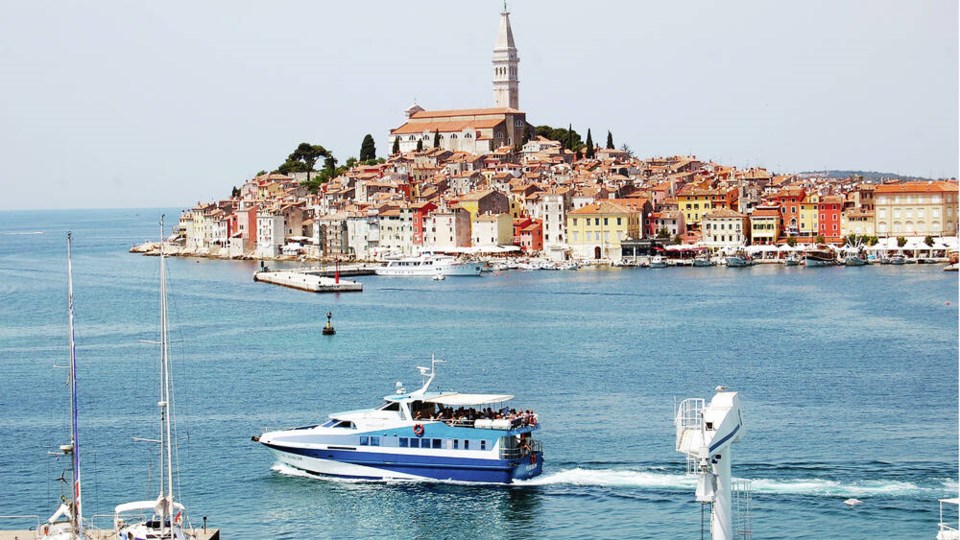The Istrian Peninsula, jutting out into the northern Adriatic Sea, offers some of the best of coastal Croatia and nearby Italy, but with fewer crowds. It’s an inviting mix of Roman history, vineyard-draped hill towns, and pastel seaside villages with a whiff of Venetian flair.
While the peninsula has its share of tacky and forgettable resort towns, the seafront port of Rovinj — like a little Venice on a hill — is one of my favourite small towns on the Mediterranean.
Rising dramatically from the Adriatic as though being pulled up to heaven by its grand bell tower, there’s something particularly romantic about Rovinj. Some locals credit the especially strong Venetian influence here — it’s the most Italian town in Croatia’s most Italian region. Rovinj’s streets are delightfully twisty, its ancient houses are characteristically crumbling, and its harbour still hosts a real fishing industry.
Pula, on the other hand, isn’t quaint. Istria’s biggest city is an industrial port town with traffic, smog, and sprawl … but it has the soul of a Roman poet. Between the shipyards, you can discover some of the top Roman ruins in Croatia, including its stately amphitheatre — a fully intact mini-Colosseum that marks the entry to a seedy Old Town with ancient temples, arches, and columns.
Of the dozens of amphitheatres left around Europe and North Africa by Roman engineers, Pula’s is the sixth-largest, and one of the best-preserved anywhere. Throughout the Middle Ages, scavengers scraped the amphitheatre as clean as a nice slice of cantaloupe, leaving just the outside intact. Standing inside, though, you can imagine when it was ringed with two levels of stone seating and a top level of wooden bleachers. You can still see the outline of the actual arena (sandy oval grounds) with the small moat — just wide enough to keep the animals off the laps of those with the best seats, but close enough so that blood still sprayed their togas.
Like most Roman towns, Pula had a forum, or main square. Twenty centuries later, Pula’s Forum still serves the same function. The Temple of Augustus, which faces the square, took a direct hit from an Allied bomb in the Second World War, but was rebuilt after the war. (On one visit I asked my guide if it was an American bomb that destroyed the temple, and he answered sheepishly, “Yes, a little bit.”)
Most tourists in Croatia focus on the coast. For a dash of variety, head inland to check out the hill towns. In Istria my favourite two are tiny, rugged, and relatively untrampled: the artists’ colony of Gro啪njan and popular Motovun, with sweeping views of the surrounding countryside.
Gro啪njan is a trapped-in-a-time-warp Istrian hill town, artfully balanced on the tip of a vine-and-olive-tree-covered promontory.
Its stony, leafy, rough-cobbled lanes are lined with art galleries and, like most Istrian towns with any tourism, shops selling locally produced olive oil and truffle oil. Not long ago, Gro啪njan was virtually forgotten.
But now artists have taken up residence here, keeping it Old World but with a spiffed-up, bohemian ambience.
Dramatically situated high above vineyards, Motovun (population: about 1,000) is the best known and most touristed of the Istrian hill towns. And for good reason: Its hilltop Old Town is particularly evocative, with a colourful old church and a rampart walk with spine-tingling vistas across the entire region. It’s hard to believe that race-car driver Mario Andretti was born in this tranquil little traffic-free hamlet.
As you explore, you’ll see frequent signs for wineries, olive-oil producers and truffle shops. One recent trend in Istria is the emergence of agroturizams. Like Italian agriturismi, these are working farms that welcome tourists for a taste of traditional rural life.
Opatija, just outside of the peninsula, is not your typical Croatian beach town. In the late-19th-century golden age of the Austro-Hungarian Empire, this unassuming village was transformed into the eastern Riviera, one of the swankiest resorts on the Mediterranean. While the French, British, and German aristocracy sunbathed on France’s Côte d’Azur, the wealthy elite from the eastern half of Europe — the Habsburg Empire and Russia — partied in Opatija.
While the Habsburgs and Russians are long gone, Opatija retains the trappings of its genteel past. Most of Croatia evokes a more ancient Mediterranean, but Opatija whispers “belle époque.” With its welcoming and elegant promenade, it may be the classiest resort town in Croatia, with more taste and less fixation on postcards and seashells.
The local tourist board carefully manicures this region’s image as the hot spot in Croatia to find hill towns, backcountry drives, and a laid-back and relaxing lifestyle. These days, some travellers even mention Istria in the same breath as Tuscany or Provence. While that may be the region’s malvazija wine and truffle oil talking, Istria is, by any measure, a delight in itself.
Rick Steves (www.ricksteves.com) writes European guidebooks, hosts travel shows on public TV and radio, and organizes European tours. You can email Rick at [email protected] and follow his blog on Facebook.



